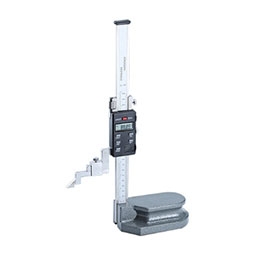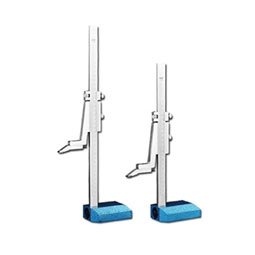The height gauge is a precision measuring instrument used to measure the height, position, or size of an object. These height gauges are categorized by different operating principles and sensing technologies to suit different applications. Below are the common types of height gauges, as well as the classification and details of height gauges.
Mechanical Height Gauge
A Mechanical Height Gauge is a traditional height-measuring instrument that usually uses mechanical triggering to take measurements. It consists of a fixed base and a movable probe. A mechanical height gauge is a contact measuring device, which is operated manually or mechanically by touching a target object with a moving probe or needle tip and then measuring the distance the probe moves to determine the height.
Advantages are that they are simple, robust, and low cost, and can measure a wide range of materials including metals, plastics, and wood. The disadvantages are that they require physical contact with the target object, which can sometimes lead to damage, are dependent on operator skill, and are susceptible to operator error. This type of height gauge is suitable for applications that require direct contact with the object to be measured, such as measuring the height or depth of a part.
Digital Height Gauge
A digital height gauge is an advanced height measurement instrument with a digital display and electronic controls that provide greater accuracy and readability. It can include a digital scale and an LCD or LED display that reads the measurement to a few decimal places. Digital height gauges can often perform non-contact measurements, providing easier operation and data logging capabilities. Digital height gauges use a digital sensor to measure height and then display the results on a digital screen.
Some digital height gauges can also be connected to a computer or data acquisition system to automatically record data. Digital height gauges are typically used for precision measurements and quality control applications. Advantages include high accuracy and repeatability. The digital display is easy to read and reduces reading errors. Data can be stored and transferred for easy data analysis and recording. The disadvantage is the need for batteries or a power supply.
Laser Height Gauge
The Laser Height Gauge is a non-contact height measurement instrument that uses laser technology to make measurements. A laser height gauge uses laser technology to measure the height or position of an object. It calculates distance by firing a laser beam and measuring the time or phase difference of the laser beam's reflection back. This type of height gauge is usually very accurate and can be used remotely for non-contact measurements.
It is suitable for applications that require high accuracy and speed, such as measuring the dimensions of mechanical parts. They are widely used in applications that require high accuracy and non-contact measurements. Advantages are non-contact measurement, avoiding object damage, high accuracy, and fast measurement for complex shapes and surfaces. The disadvantage is that they are sensitive to light interference and need to avoid bright light interference.
Vernier Height Gauge
The vernier height gauge is a precision measuring tool used to measure the height of an object. A vernier height gauge usually consists of a body, a movable vernier, and a dial or scale. The height of an object is measured by placing the bottom of the body in contact with the object being measured and then adjusting the position of the vernier. The vernier usually has a tiny scale that can be used to read the height value, usually in millimeters or inches. Vernier height gauges are usually highly accurate and are capable of measuring height variations as small as a few tenths of a millimeter. These height gauges are often of very rugged construction to ensure accurate and repeatable measurements and are used in a variety of applications such as quality control, parts machining, assembly work, and scientific research.
Ultrasonic Height Gauge
Ultrasonic height gauges are also non-contact height measuring instruments that use ultrasonic technology to make measurements. The Ultrasonic Height Gauge determines distance by transmitting an ultrasonic pulse and measuring the round trip time of the pulse. The instrument emits the pulse and then measures the time it takes for the pulse to travel from the instrument to the target object and back again to determine the distance. This type of height gauge is typically used for non-contact measurements.
Ultrasonic height gauges are suitable for applications where non-contact measurements are required, such as liquid level measurement, obstacle detection, and building height measurement. Advantages are non-contact measurement, no need to physically touch the target object, suitable for complex shapes and surfaces, and can measurement of the liquid level located in the liquid level meter. Disadvantage are sensitive to temperature and humidity changes. The measuring range is limited and not suitable for long-distance measurement.
Common Uses in the Application Field
- Manufacturing: Height gauges are widely used in the manufacturing industry to measure the height, size, and straightness of parts, workpieces, and products, helping to ensure that products comply with the required standards and improve product quality and manufacturing efficiency.
- Automotive Manufacturing: Height gauges are used in the automotive manufacturing industry to measure the height and position of body parts to ensure that components are assembled accurately. This helps produce vehicles that meet safety and performance standards.
- Aerospace Industry: In the aviation and aerospace sectors, high accuracy height gauges, are used to measure the height and dimensions of aircraft parts, wings, engine parts, etc. This helps ensure the safety and performance of aircraft.
- Medical Device Manufacturing: In medical device manufacturing, height gauges are used to measure the dimensions and height of medical devices to ensure they meet medical standards. This is critical to patient safety and treatment outcomes.
- Electronics Manufacturing: Height gauges are used in electronics manufacturing to measure the height and dimensions of circuit boards, chips, and components. This helps ensure the performance and reliability of electronic devices.
- Building and Civil Engineering: In building and civil engineering, height gauges are used to measure the height and topography of buildings, bridges, roads, and other infrastructure. This is essential for planning, design, and construction.
- Geo-mapping: Height scales are used in geo-mapping and Geographic Information Systems (GIS) to measure ground height, topography, and geographic data. This helps to create maps, plan cities, and manage natural resources.
- Food Processing and Pharmaceuticals: In the food processing and pharmaceutical industries, height gauges are used to measure the size, height, and assembly accuracy of food and pharmaceutical products. This helps ensure product compliance and quality.
- Quality Control: Height gauges are used for quality control and inspection to verify that the height and dimensions of a product comply with standards. This applies to a variety of manufacturing industries.

Height gauges are versatile measuring tools for a wide range of applications, from traditional mechanical height gauges to high-precision laser and ultrasonic height gauges. Understanding the different types of height gauges and how they work can help in selecting the right measuring tool for a particular application to ensure high-quality results. sisco store can provide you with a choice of high quality, high accuracy height gauges, whatever your question, we are here 24 hours a day to help you, welcome to visit us. Height measurement is of key importance in manufacturing, scientific research, quality control, and engineering applications, helping to ensure product quality, improve productivity, and promote the development of scientific research.

